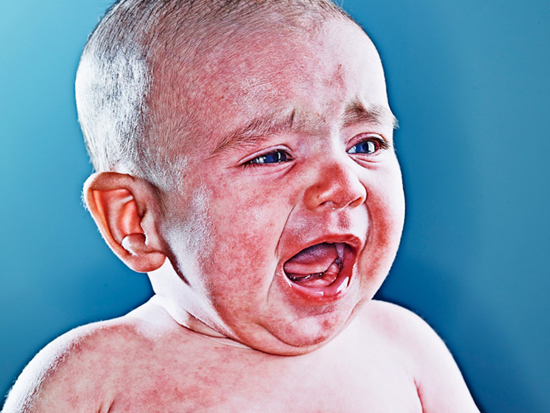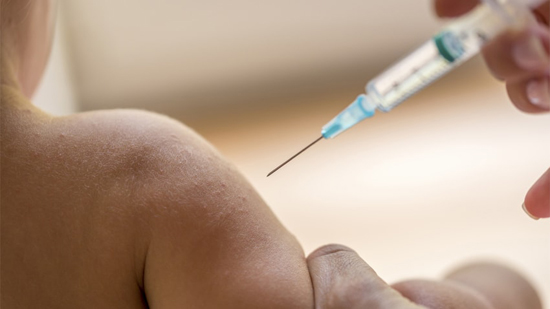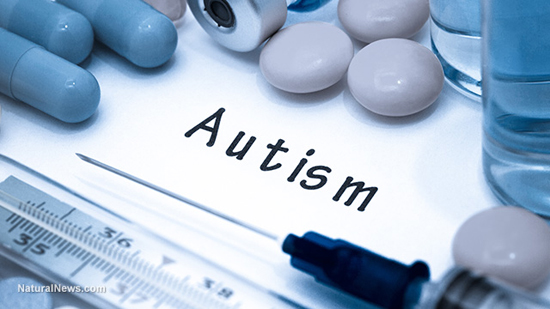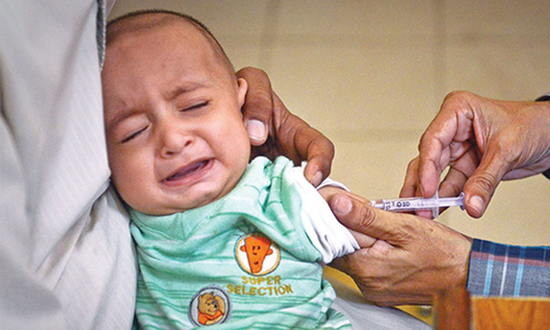Side Effects of the Measles Vaccine Include Brain Damage and Death (2)
Read the first part of the article
One example of an MMR vaccine injury claim awarded compensation in the VICP is the case of O.R. On February 13, 2013, O.R. received the MMR, Haemophilus Influenzae type B, Pneumococcal (Prevnar 13), Hepatitis A, and Varicella vaccines. That evening, following vaccination, she became feverish and irritable prompting her mother to contact the doctor. The doctor advised O.R.’s mom to administer Benadryl and Tylenol for her symptoms.

The fever persisted for several days and was followed by a severe seizure resulting in cardiac and respiratory arrest. The cardiac arrest and seizures caused O.R. to develop encephalopathy, kidney failure, severe brain injury, low muscle tone and cortical vision impairment.
After several months of inpatient hospitalization, O.R. was discharged home with 24-hour supervised medical care. On November 20, 2017, the court conceded that the MMR vaccine caused her encephalopathy and O.R. was awarded a $101 million dollar settlement to cover medical expenses for the rest of her life.
In 1998, public health officials and attorneys associated with the federal Vaccine Injury Compensation Program published a review in Pediatrics in regards to the medical records of 48 children ages 10 to 49 months, who received a measles vaccine or combination MMR vaccine between 1970 and 1993 and developed encephalopathy after vaccination.
The children either died or were left with permanent brain dysfunction, including mental regression and retardation, chronic seizures, motor and sensory deficits and movement disorders. The study authors concluded that: “The onset of neurologic signs or symptoms occurred with a nonrandom, statistically significant distribution of cases on days 8 and 9. No cases were identified after the administration of monovalent mumps or rubella vaccine. This clustering suggests that a causal relationship between measles vaccine and encephalopathy may exist as a rare complication of measles vaccination.”
Nearly two decades earlier, in 1981, a report of the National Childhood Encephalopathy Study was published in Britain that concluded: “The risk of a serious neurological disorder within 14 days after measles vaccine in previously normal children irrespective of eventual clinical outcome is 1 in 87,000 immunizations.”
However, a 2007 study conducted in Britain concluded “We can estimate the vaccine-attributable risk of serious neurologic disease after the first dose of MMR vaccine as 1 in 365,000 doses.”
As well, published studies have shown that the MMR vaccine components or excipients, particularly egg antigens and porcine or bovine gelatin, can trigger both immediate and delayed anaphylactic reactions.
In Guinea-Bissau, Dr. Peter Aaby has studied and administered vaccines to thousands of children for more than three decades and has published research on vaccine safety and effectiveness, including research on measles and measles vaccine.
He found that there can be marked differences in the way that boys and girls respond to vaccines and noted an increased risk of mortality in girls who received DTP and measles vaccines at the same time.
He also found that fatality rates were increased for children ages 6 months to 17 months old, if they had received the DTP vaccine simultaneously with or after receiving measles vaccine.
In 1995, Swiss researchers discovered the presence of the reverse transcriptase (RT) enzyme in the live measles and mumps vaccine, and traced it back to the cells of the chickens used to create the vaccine.
Reverse transcriptase is responsible for copying RNA into DNA and its activity is associated with the presence of retroviruses, a class of viruses that has the ability to permanently alter the genes of the cells they infect.
While the World Health Organization (WHO) and the CDC reviewed the findings, they were also quick to dismiss them, with the CDC publicly stating that “we are not investigating a situation in which there has been any adverse reaction at all.”
Independent researchers have expressed concerns that the use of animal tissues for the production of human vaccines such as the live MMR vaccine may facilitate the transfer of viral infection from animals into man causing as yet undetected and unevaluated negative health effects on humans.

The first evidence of persistent measles virus infection of the intestine after measles vaccination was discovered in 1995 by British researchers.
In 1998, an association between live virus measles vaccine, inflammatory bowel disease (IBD) and regressive autism was hypothesized by gastroenterologist Dr. Andrew Wakefield and other physicians at Royal Free Hospital after they detected the presence of measles virus in the intestines of children suffering with Crohn’s disease and autism.
The paper, published in The Lancet, suggested MMR vaccine may be associated with development of regressive autism in previously healthy children, was immediately met with intense anger and criticism from public health officials and medical trade associations.
Hans Asperger had observed a high rate of gastrointestinal (celiac) disease in children diagnosed with autism, and these observations prompted Wakefield and his colleagues to further examine this association.
After studying children who were suffering from inflammatory bowel disease and were receiving treatment at Royal Free Hospital in the United Kingdom, the researchers hypothesized that a persistent viral infection, either from natural measles disease or live virus measles vaccine, could cause chronic inflammation in the bowel and damage to the central nervous system in some children.
However, in their paper they emphasized that they had not proven a cause and effect relationship between autism, MMR vaccine and non-specific colitis, which they described as “autistic ileal-lymphoid-nodular hyperplasia,” but rather called for more studies to explore the potential relationship.

Additional independent studies on this subject have also reported the presence of measles virus in association with gastrointestinal disorders, such as enterocolitis and chronic intestinal inflammation.
Today, the majority of doctors and health officials reject the suggestion that MMR vaccine is associated with the development of autism in children.
However, privately funded research continues to investigate the potential association between vaccines, including MMR vaccine, and the development of autism, inflammatory bowel disease and other kinds of brain and immune system dysfunction in previously healthy children.
The MMRII and the ProQuad (MMR-V) product inserts report the following:
• Measles inclusion body encephalitis, pneumonitis, and death have occurred in severely immunocompromised individuals who were inadvertently vaccinated. Disseminated mumps and rubella infections have also been reported in this population.
• Subacute sclerosing panencephalitis (SSPE) has been reported in children without a history of wild-type measles infection, however, these children were documented to have received measles vaccine. The vaccine product insert speculates that some cases may have either resulted from measles vaccination or from a possible unrecognized case of measles in the first year of life.
• In the majority of susceptible individuals, small amounts of the live attenuated rubella virus have been excreted from the throat or nose 7 to 28 days following vaccination. According to the vaccine product insert, no evidence has confirmed that the rubella virus can be transmitted to susceptible individuals who come into contact with vaccinated persons. Transmission through close personal contact have been accepted as being theoretically possible but it is not considered a significant risk.
• Transmission of the rubella vaccine virus through breast milk has been noted and postpartum women vaccinated with a live attenuated rubella vaccine may transmit the virus to their breast-fed infants. In one study, several infants were found to have serological evidence of rubella infection without severe disease, however, one infant was noted to have a mild illness found to be typical of rubella.
• Vaccine product inserts for MMR and MMR-V deny any reports of transmission of live attenuated mumps or measles viruses from persons vaccinated and susceptible close contacts. Measles or mumps vaccine virus secretion in human milk is not known.
In November 2014, the National Vaccine Information Center published a special report The Emerging Risks of Live Virus and Virus Vectored Vaccines: Vaccine Strain Virus Infection, Shedding and Transmission. This report reviewed the medical literature for evidence that live virus vaccine strain infection, shedding, and potential for transmission occurs, including measles vaccine strain infection and shedding.

There have been published reports of vaccine strain measles infection with clinical symptoms that are indistinguishable from wild-type measles. There are also a few reports of measles vaccine strain virus shedding and lab confirmed infection in children following MMR vaccination. In 2002, there was a published report by researchers in France of “a child presenting with fever 8 days after vaccination with a measles-mumps-rubella vaccine. Measles virus was isolated in a throat swab taken 4 days after fever onset. This virus was then further genetically characterized as a vaccine-type virus.”
In 2010, Eurosurveillance published a report about the shedding of vaccine strain measles virus in urine and throat secretions of a Croatian child with vaccine-associated rash illness.
A healthy 14-month old child was given MMR vaccine and eight days later developed macular rash and fever. Lab testing of throat and urine samples between two and four weeks after vaccination tested positive for vaccine strain measles virus. Authors of the report pointed out that when children experience a fever and rash after MMR vaccination, only molecular lab testing can determine whether the symptoms are due to vaccine strain measles virus infection. They stated: “According to WHO guidelines for measles and rubella elimination, routine discrimination between aetiologies of febrile rash disease is done by virus detection. However, in a patient recently MMR-vaccinated, only molecular techniques can differentiate between wild type measles or rubella infection or vaccine-associated disease. This case report demonstrates that excretion of Schwartz measles virus occurs in vaccinees.”
In 2012, a report was also published describing a healthy 15-month old child in Canada, who developed irritability, fever, cough, conjunctivitis and rash within seven days of an MMR shot.
Blood, urine and throat swab tests confirmed a vaccine strain measles virus infection 12 days after vaccination. Addressing the potential for measles vaccine strain virus transmission to others, the authors stated: “While the attenuated virus can be detected in clinical specimens following immunization, it is understood that administration of the MMR vaccine to immunocompetent individuals does not carry the risk of secondary transmission to susceptible hosts.”
IMPORTANT NOTE: Even though the American College of International Physicians says it’s safe to give other viral and bacterial vaccines at the same time as MMR vaccine, Merck’s MMRII product information insert states that other live virus vaccines – such as varicella – should NOT be given at the same time as MMR vaccine but rather should be administered one month prior or one month after the MMR vaccination.
yogaesoteric
May 27, 2019
